#parrot crossbill
Text
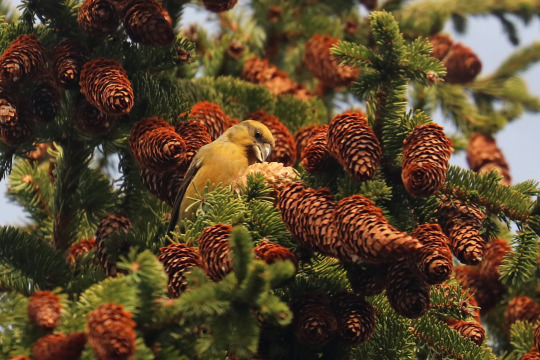
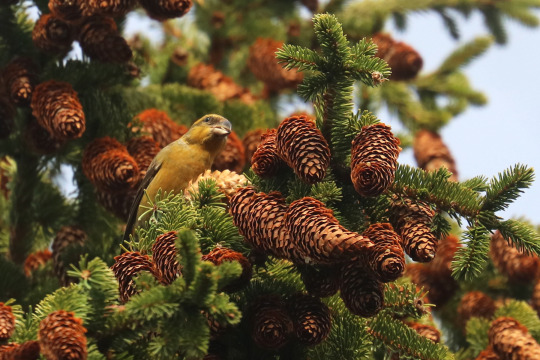
Parrot crossbill/större korsnäbb. Värmland, Sweden (January 25, 2020).
768 notes
·
View notes
Text
Animal of the Day!
Parrot Crossbill (Loxia pytyopsittacus)
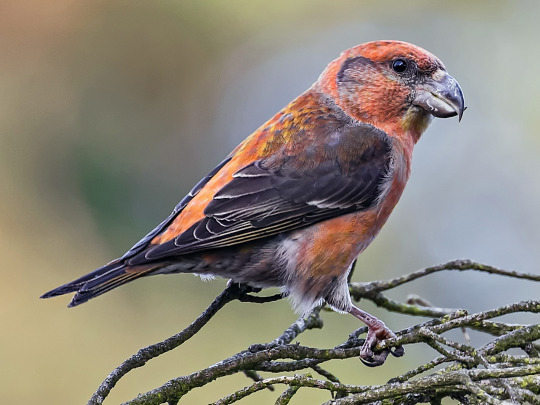
(Photo by John George Richardson)
Conservation Status- Least Concern
Habitat- Europe; Russia
Size (Weight/Length)- 55 g; 17 cm
Diet- Tree seeds
Cool Facts- The parrot crossbill is one of the only birds to naturally have their top beak mandible cross over their lower one. Their beak helps them to feed on pine nuts without having to husk the entire pinecone. The crossbill inserts its lower mandible into the pinecone and presses up on the scale with its upper. This gives the bird time to grab the pine nut with their tongue before moving on to get the next seed. They’re essentially the squirrels of the bird world. Parrot crossbills have distinct sexual dimorphism with the males being bright red and the females being green or yellow.
Rating- 12/10 (Their scientific name is translated to crosswise pine parrot.)
#animal of the day#animals#birds#crossbill#saturday#september 30#parrot crossbill#biology#science#conservation#the more you know
225 notes
·
View notes
Photo

Parrot Crossbill
6 notes
·
View notes
Photo
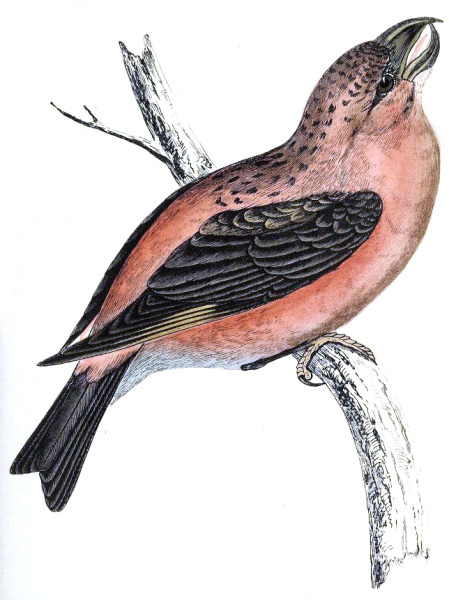
A new variant has been added!
Parrot Crossbill (Loxia pytyopsittacus)
© Francis Orpen Morris
It hatches from big, common, deep, greenish, heavy, identical, and red eggs.
squawkoverflow - the ultimate bird collecting game
🥚 hatch ❤️ collect 🤝 connect
0 notes
Text
Me to all my friends: do you think Brennan Lee Mulligan would like my bird?
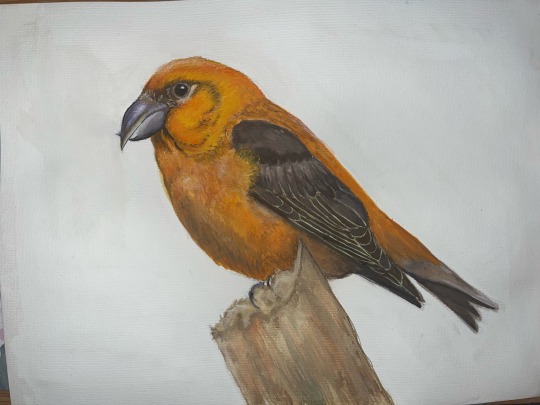
#brennan lee mulligan#i fucking love birds#birds#Scottish crossbill#though it looks like a parrot crossbill tbh#they’re hard to tell apart#I often think of the crossbill as a Christmas bird because the females are green and the men are orange-red and that screams Christmas to m#the Scottish crossbill is the uks only endemic bird#I think I got the wording right#they’re passerines#they’re finches#they kinda look like dinosaurs to me
3 notes
·
View notes
Text
thoughts on west endsies because now that i've been five times i feel like i should hop on this bandwagon
(below the cut)
- mark. mark's mike is so clearly extremely anxious and uncomfortable in large crowds a lot of the time. when he comes on behind specs after they raise the prices he's fidgeting with his necktie and he looks so small and. i live for this okay
- more on that. mike is the last newsie to leave the theatre after jack scabs and when he goes up to jack he looks so vulnerable. god i want to give him a hug
- race covers romeo's eyes during that's rich mocking the way davey covers les' and i love it
- damon's davey. i have so much to say about this. he's so different from ryan's davey in that his anxiety manifests itself as being EXTREMELY uptight and straightforward ?? and the way he gets more and more comfortable over the course of the show ... so normal about it fr
- the javey with damon's davey is MSDJSNF because damon's davey is that little bit more physical and up-close and it makes the javey like. 15x stronger
- ross saying "IT'S ABOUT TIME" when jack and katherine kiss during the finale
- jomike. platonically or otherwise it is so real in this production it is so canonical and i will die on this hill. last time i went mukeni fully picked mark up bridal-style while they were waiting for their papers. they're besties your honour
- speaking of. ralbert. this is an entirely different breed of ralbert and it's so perfect. they feel ?? older ??? more mature but not in the make-sensible-decisions way just in the make-stupid-decisions-despite-having-properly-thought-them-through-and-knowing-full-well-they're-stupid way
- ngl during seize the day they fully nearly dropped matt if morgan hadn't been standing behind him and caught him he would have gone splat
- speaking of. morgan's finch is a parrot crossbill sorry i don't make the rules
- i am headcanoning specs and albert as having evening jobs working at medda's theatre because they operate the lights during that's rich. it's canonical guys you heard it here first
- owen had a fake moustache for bill ... i do not enjoy that at all <- he is petty and does not like change (also the colours of bill and darcy's costumes are switched around from livesies and it is SO confusing. the suits are so gorgeous but please my poor brain can't handle the confusion)
anyways this was a long time coming i might add more next time i see it (like. two and a half weeks) (look forward to it)
13 notes
·
View notes
Video
Parrot crossbill - Loxia pytyopsittacus by seamusandpat
Via Flickr:
At Santon Warren, Thetford Forest, Norfolk, UK.
#Loxia pytyopsittacus#parrot crossbill#crossbill#thetford#thetford forest#bird#birds#pine#forest#forestbirds#loxia
1 note
·
View note
Photo

Parrot crossbill
1 note
·
View note
Photo





Parrot crossbill/större korsnäbb. Värmland, Sweden (January 25, 2020).
685 notes
·
View notes
Photo
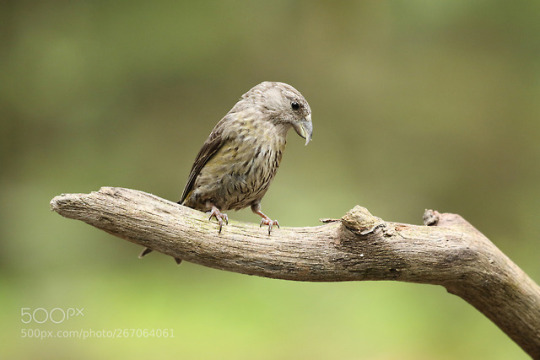
Parrot crossbill by @JokeHulst
1 note
·
View note
Photo
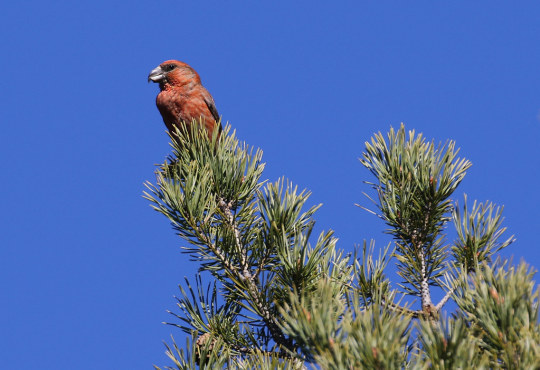
Parrot Crossbill - male by Wild Chroma Parrot Crossbill (Loxia pytyopsittacus) Tyresta National Park, Sweden https://flic.kr/p/2iTh8rN
1 note
·
View note
Video
youtube
This is easily the closest I've ever got to a feeding crossbill. Filmed on Mar Lodge Estate recently, it happily foraged among the pine cones for at least 10 minutes while I watched. I couldn't tell you the species (there are several) as I'm really not familiar with these birds, but they're all weirdly parrot like in appearance.
You can see it bite the cone off the branch with no difficulty whatsoever, but I hadn't realised how very dexterous they are with their feet thereafter, holding the cones in place and then manoeuvring them with ease. I love how you can see it actually turning its head to physically prise the scales apart with that distinctive 'crossed' beak, in order to get at the seeds inside. A true pine specialist. Amazing :)
31 notes
·
View notes
Text
I haven’t quite perfected my bird spreadsheet yet, but I have all of the frequency statistics in place so I can see which are the most and least common British birds. Remember that these statistics are the frequency with which birdwatchers recording data on the BirdTrack website record the species in their checklists during the peak week for that species (so the frequency would be less for any other week). So it’s not exactly “common” and “rare” that we’re talking about, but some combination of actual rarity, accessibility and ease of identifiability, and it’s all with respect to the time of year at which each bird is most common.
Most common
The single most common bird in the UK, by this measure, is the blackbird, which appears in 77.75% of lists during the peak week (in December), and is similarly frequent during the rest of the year although there’s a dip to about 45% from July to November. This doesn’t surprise me at all. Blackbirds are very common, are often found near urban areas and gardens, and are very easy to identify.
Not far behind is the woodpigeon, which appears in 75.89% of lists. I have only recently started noticing this bird as distinct from the feral pigeon, but certainly here in Edinburgh, woodpigeons are very abundant so this doesn’t surprise me either. I’m sure feral pigeons would be very high up on the list, and probably higher than blackbirds and woodpigeons if they were counted, but I guess most birdwatchers don’t count feral birds in their lists. The woodpigeon is by far the most common non-songbird.
Four runners-up around the 70% mark are the robin (71.30%, March), the chaffinch (70.10%, April), the blue tit (68.92%, March) and the carrion crow (68.37%, March). Crows being here is no surprise---they’re very common in my experience. The other three are moderately surprising to me. I have seen plenty of robins, but they’re still a bird I'm somewhat excited to see when I see one (I saw a lot of them in York, but I don’t think I’ve seen one since coming to Edinburgh; and I’ve seen them in my garden at home in Rainhil now and then, but not tremendously often). And I’ve never seen a chaffinch, or a blue tit. Maybe I’ve passed over chaffinches because I’m not very familiar with them. But I think I’d know a blue tit if I saw one. I see lots of tits, but they’re all great tits.
That said, great tits are close behind, at 63.82% during April. In a similar league are wrens (64.62%, April), which is unsurprising to me. I don’t see wrens all that often, but they’re tiny and not always easy to spot so the fact that I do spot a fair few nonetheless is a testament to how common they are.
The remaining birds that appear in over half of lists at their peak weeks are magpies (60.43% in December), swallows (58.55% in September), dunnocks (57.45% in March), black-headed gulls (56.93% in January), mallards (55.34% in April), chiffchaffs (54.49% in April), and starlings (53.09% in November). Note that swallows, chiffchaffs and starlings are migratory birds which are absent during the winter (for swallows and chiffchaffs) and the summer (for starlings), whereas all the other birds I’ve mentioned up to now are year-round residents, so these migatory birds can be counted as a little more hard-to-find on that basis. I’ve never knowingly seen a dunnock or a chiffchaff, but I’ve seen all the others; and probably the reason I’ve never seen a dunnock or a chiffchaff is that I don’t know what these birds look like.
I imagine if you put “gulls” in an aggregate they might end up appearing on 80% or 90% of lists, but since there are quite a few species and they’re hard to differentiate the figure is less; still, black-headed gulls getting onto 56.93% of lists is quite impressive.
Most of the commonest birds are songbirds. The only other non-passeriforms appearing in more than a third of lists at peak are swifts (42.91% in July), pheasants (41.31% in April), herring gulls (38.18% in October), moorhens (37.70% in March), cormorants (35.60% in September), and grey herons (33.83% in September). All of these are birds that I have seen frequently.
Somewhat surprisingly, the most common bird of prey is the buzzard (28.81% in April). I would have thought it’d be the kestrel; I’ve never seen a buzzard. Apparently they were once rare due to persecution, but have now greatly increased in numbers. The kestrel is still not far behind at 26.52% in October. The most common owl is the little owl (3.22% in July), which is actually an introduced species---of course owls suffer in these figures from being hard to see.
The most common wader is the oystercatcher (26.12% in July); the most common woodpecker is the great spotted woodpecker (22.51% in April); the most common procellariiform is the fulmar (7.71% in August); and the most common diver is the red-throated diver (5.00% in September).
Rarest
There are some birds that have only been recorded a handful of times (or even just once) in the British Isles, as vagrants from their normal range, such as albatrosses. Many vagrants, if sighted in the wild, can be reported to the British Rare Birds Committee who will assess the veracity of the claim and publish a report on it. However, there are a lot of vagrants which occur regularly enough in the British Isles that the British Rare Birds Committee no longer includes them on the list of birds it studies; these birds are known as “scarce migrants”. I’ve included only vagrants with scarce migrant status in my spreadsheet. Naturally, most of the rarest birds on the spreadsheet are among these scarce migrants. The two joint rarest are the black kite (0.03% in May) and the aquatic warbler (0.03% in August), although the exact figures are probably not very meaningful when they’re so low. Every possible two-decimal place percentage from 0.03% up to 0.15% is populated by a number of species, mostly scarce migrants.
There are a few non-scarce migrants populating these percentages too, though. The rarest, at 0.05%, are the golden pheasant (February), the parrot crossbill (January) and the Scottish crossbill (April). The Scottish crossbill is particularly notable for being the only bird species endemic to the British Isles. However, its rarity according to these figures may be a little misleading. The Scottish crossbill and the parrot crossbill are actually pretty much identical in appearance to the common crossbill (1.45%, October), differing only slightly in the shapes of their bills, which isn’t much use when you can’t make precise measurements. They do have somewhat different calls (which are recognized as different by the birds, so that the three species don’t interbreed, though they probably would be capable of fertile hybridization), although the calls are still quite similar; so the low figures for the parrot crossbill and the Scottish crossbill may be due to birdwatchers assuming any crossbill they come across is a common crossbill, given that they have little chance of successfully distinguishing the three species.
The golden pheasant's rarity is also somewhat misleading because this is an introduced species with a very limited range. If you go to one of the forests where golden pheasants are known to roam, they probably won’t be quite as elusive as the 0.05% figure suggests (although they’re still definitely not easy to find). Another species of introduced pheasant, Lady Amherst’s pheasant, was in a similar situation but the population has now almost died out---there is apparently just one male remaining in a forest in Bedfordshire.
So the rarest non-scarce migrant which isn’t an introduction or practically the same as a commoner species is the capercaillie (0.07%, April). This is not too surprising as the capercaillie is one of the most endangered British birds at the moment. They already went extinct once here during the 18th century; they were reintroduced during the 19th but recently they’ve started approaching extinction again due to habitat loss. Although large and very recognizable, capercaillies are pretty inaccessible as they live only in the pine forests of the Scottish highlands.
The frequencies for ptarmigans are also very low---the peak is 0.11% in May. But this is probably in large part due to the fact that ptarmigans are only found at very high elevations in the Scottish highlands, and it’s not every day that birdwatchers go climbing mountains. Likewise, crested tits (0.15%, August) owe their rarity to their localization to a few ancient Scottish forests. White-tailed eagles (0.17%, May) have a similar story to the capercaillie---they were almost eradicated and have since been reintroduced---the reintroduction is going better than the capercaillie reintroduction, but it’s only begun recently so the birds are still pretty rare. Cirl buntings (0.20%, August) are only found in southern Devon. So the rarest resident British bird which still has a reasonably wide distribution is--actually there are two joint winners: the golden eagle (0.33%, June), a very charismatic rarity, and the hawfinch (0.33%, January). According to Wikipedia the hawfinch only started breeding in the British Isles during the 19th century, and they have always been quite rare, although there has been a decline from peak numbers in the 1980s.
1 note
·
View note